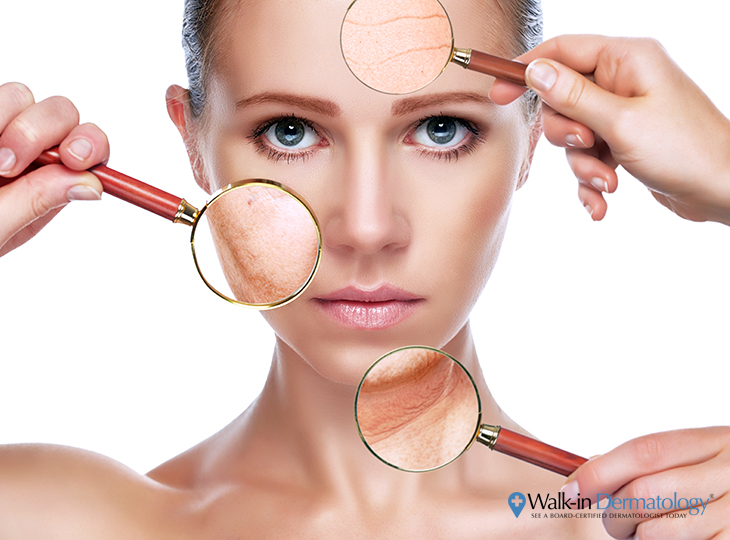Tues: 8:30am - 3:00pm
Wed: 12:00pm - 6:00pm
Thurs: 8:30am - 3:00pm
Fri: Closed
Sat: 8:30am - 12:30pm
Sun: Closed
Greenvale, NY 11548
Prejuvenation: How to Prevent those Tell-tale Signs of Skin Aging before they Begin


We’ve all heard of skin rejuvenation, the beauty treatments that can revitalize our appearance and help restore a youthful look.
But prejuvenation? This is a multi-step process of stopping aging skin in its tracks. The goal is to prevent or slow down the changes that come as we grow older. Fine lines. Wrinkles. Thinning skin. Brown/aging spots.
Think of it as preventive maintenance. Take care of your skin today and you’ll experience fewer problems tomorrow. Maybe none at all. See, the skin changes that can come with aging are mostly preventable. Begin your prejuvenation regimen early enough and you can virtually eliminate the most common signs of aging skin.
It’s also much easier to prevent skin aging problems than to correct them after the damage is done.
There are 6 fundamental steps you can take if you want to prejuvenate your skin and maintain that glow of youth:
- UV protection
- Use antioxidants and retinoids
- Injectable neuromodulators
- Skin resurfacing
- Fillers and collagen replacement
- Skin renewal and revitalization
Let’s go through each one.
Step 1: UV Protection
To slow or even stop the signs of aging – and protect yourself from skin cancer, which is the most common form of cancer in the United States – use a quality sunscreen when working or playing outdoors. Sunscreen lotions help prevent wrinkles, brown spots and collagen loss, which can lead to sagging skin and hollowing around the cheeks.
Use sunscreen with a protection factor rated at 30 or above, following the recommendations of the American Academy of Dermatology. Applying sunscreen from an early age is one of the best things you can do to prevent signs of aging skin in the years to come. It will help prevent photodamage, which is skin damage caused by solar radiation – the UV rays of the sun.
Step 2: Use Antioxidants and Retinoids
Products containing antioxidants and retinoids help prevent loss of collagen, which is the protein that gives skin a smooth and resilient quality. Antioxidants absorb the damaging effects of free radicals, which are molecules that can be found in smoke, pollution, radiation and even some medications, according to the National Institutes of Health. Some retinoid topical ointments are available over-the-counter, while stronger formulations require a prescription. Dermatologists recommend using preparations containing antioxidants and retinoids when you’re in your late 20s or early 30s, which is typically when you’ll begin to see signs of photodamaged skin.
Step 3: Injectable Neuromodulators
Botox injections are the most common – and safest – non-surgical treatment for lines and wrinkles on the upper face. Botox reduces muscle contractions so facial muscles become less stiff. When these muscles are relaxed, your skin is less likely to form fine lines across your forehead or crow’s feet around the eyes. These injections are often used by dermatologists to treat wrinkles, but are an effective prevention tool as well. As with antioxidants and retinoids, beginning a regimen of Botox treatments in your 20s or early 30s can help eliminate the need for more aggressive rejuvenation therapies years later.
Step 4: Skin Resurfacing
You can remove unsightly brown spots, erase signs of sun-damaged skin and stimulate collagen growth through skin resurfacing. Early treatment can reduce the need for multiple treatments later in life when skin damage has worsened. Laser skin resurfacing is a painless outpatient procedure that produces noticeable results from your first session.
Step 5: Fillers and Collagen Replacement
Injectable cosmetic fillers replace the collagen protein that’s lost as we grow older. Injectables such as JUVÉDERM and Restylane fill in facial wrinkles below the skin, restoring a smoother and younger-looking appearance. Collagen loss can begin in the early 30s. As with most cosmetic dermatology procedures, early treatment will in most cases dramatically reduce the need for more aggressive therapies as we get older. As an added benefit, fillers can help stimulate your body’s own natural production of collagen, further slowing the aging process that leads to wrinkles, sagging skin and hollow cheekbones.
Step 6: Skin Renewal & Revitalization
These procedures help you stop the clock on aging skin.
Skin revitalization, commonly known as an “IPL Photofacial,” is a non-surgical treatment using intense pulsed light. Treatments produce clearer, more beautiful skin while removing brown spots as well as signs of blood vessels and sun damage.
Imperfections on the face and body can be addressed through skin revitalization procedures. Here your dermatologist uses a non-ablative laser to treat deeper skin layers without harming the skin’s surface. Warming the deeper skin layers helps stimulate the protein production of collagen. The result is a more even skin tone and smoother texture.
Starting your prejuvenation program is a great way to defend your skin against signs of aging today, while reducing the effort and treatment that may be needed to address cosmetic concerns many years down the road.
Stay forever young. Not just in your soul, but your appearance as well.
Let Walk-in Dermatology Take Care of You and Your Skin
If you want to be proactive about your skin or if you have concerns about any skin condition and need dependable answers fast, you don’t have to wonder, worry or wait. Walk-in Dermatology is here to keep you healthy and looking young. Our team of board-certified dermatologists and experienced medical staff will address your medical and cosmetic concerns and provide the necessary care for all your skin conditions. You can also schedule an appointment with us online.
If you can’t make it to one of our offices, we can set up a Video Visit and even prescribe medications remotely. Contact us today.








